These 14 books, selected by Planetizen for lasting relevance and excellence in research and rhetoric, will continue to define the ambitions and the shortcomings of the urban planning field in the decade that was the 2010s.

Planetizen has been chronicling the most informative, controversial, and beloved books on the subject of planning (and its many intersecting fields of knowledge) every year since 2001. With that archive and knowledge as a reference, Josh Stephens and James Brasuell decided to embark on the difficult select from those lists to create a super list: the top planning books of the 2010s.
These selections are based on a subjective criteria, similar to the criteria the Planetizen team uses to select top books every year. Books were selected for their ability to enable a social movement, win mainstream attention to the niche subjects of urban planning, and excel beyond peers in prose and research.
To make a few tough cuts to the top books of the decade list, Planetizen also referred to Goodreads ratings for a more public opinion of these books and a few insights about the popularity of some of these books. For instance, ratings are lower for books written by white men with highly public positions and sometimes controversial opinions (e.g., Edward Glaeser and Richard Florida). The Planetizen team left these books on this list because of their essential role in shaping the debates surrounding planning throughout the decade. Other books that might have gained less mainstream publicity because of what might seem like esoteric subject matter still achieved some of the highest ratings among Goodreads users (e.g., The Color of Law and Zoning Rules!). The champion of winning of Goodreads readers over, in terms of ratings, is clearly Evicted, by Mathew Desmond, which achieved a rating of 4.48 out of 5. The Color of Law, by Richard Rothstein, was close behind, with a rating of 4.43.
One final note about how this list was selected: the list starts with book published in 2009 and ends with books published in 2018, because the influence of books published in 2009 was felt throughout the decade, and it's too early to tell the legacy of books published in the final year of the decade. Each book is listed here by year of publication, and with the blurb written for each at the time of their selections to the top books of the year list. A big thank you to all the Planetizen authors and editors who contributed to these lists over the years.
2009
The BLDGBLOG Book
Geoff Manaugh
Chronicle Books, 271 Pages
 Geoff Manaugh's eccentric and always-enlightening blog has been reborn as a book, full of thematic essays and interviews that discover and explore architecture and urbanism in what might seem unlikely realms. From undiscovered bedrooms to underground storm drains to the sounds of plate tectonics, many of the book's essays and brief speculations are based around the seemingly un-architectural. But Manaugh's inquisitive suppositions seek and find their connection to the built environment in a way that prompts the reader to question the limits of city function, urban design and architecture. The book consistently draws correlations between vastly interdisciplinary fields like film, literature, meteorology, urban exploration and futurism – correlations that are at once absurd and surprisingly realistic. A thoroughly illustrated and enjoyable read, The BLDGBLOG Book should find its way onto the shelf of anyone who thinks about the importance and potential of urban space and architecture. Buy the book.
Geoff Manaugh's eccentric and always-enlightening blog has been reborn as a book, full of thematic essays and interviews that discover and explore architecture and urbanism in what might seem unlikely realms. From undiscovered bedrooms to underground storm drains to the sounds of plate tectonics, many of the book's essays and brief speculations are based around the seemingly un-architectural. But Manaugh's inquisitive suppositions seek and find their connection to the built environment in a way that prompts the reader to question the limits of city function, urban design and architecture. The book consistently draws correlations between vastly interdisciplinary fields like film, literature, meteorology, urban exploration and futurism – correlations that are at once absurd and surprisingly realistic. A thoroughly illustrated and enjoyable read, The BLDGBLOG Book should find its way onto the shelf of anyone who thinks about the importance and potential of urban space and architecture. Buy the book.
Goodreads rating: 4.21 (397 ratings).
2010
Cities for People
Jan Gehl
Island Press, 288 Pages
 With a physician's understanding of humanity, Jan Gehl is able to examine planning questions of the last forty years with impressive clarity and focus. His ideals - rejection of ideology in favor of common sense, respect for people and scale - offer a panacea to many of the environmental and health crises faced in urban areas across the globe. This volume is organized succinctly, first into sections focused on human responses to locations and then, as it becomes progressively more practical, cities themselves. There is a careful blend of analysis and case study throughout, providing a backdrop to Gehl's tenets of urban living, which are disseminated at junctures within chapters. Buy the book.
With a physician's understanding of humanity, Jan Gehl is able to examine planning questions of the last forty years with impressive clarity and focus. His ideals - rejection of ideology in favor of common sense, respect for people and scale - offer a panacea to many of the environmental and health crises faced in urban areas across the globe. This volume is organized succinctly, first into sections focused on human responses to locations and then, as it becomes progressively more practical, cities themselves. There is a careful blend of analysis and case study throughout, providing a backdrop to Gehl's tenets of urban living, which are disseminated at junctures within chapters. Buy the book.
Goodreads rating: 4.33 (1,123 ratings).
2011
Triumph of the City: How Our Greatest Invention Makes Us Richer, Smarter, Greener, Healthier, and Happier
Edward Glaeser
The Penguin Press HC, 352 Pages
 In a previous era, Harvard professor Ed Glaeser, bedecked in his trademark three-piece suit, might have been the one of the technocrats out there with his slide rule and transit, "scientifically" deciding just how much of a neighborhood to knock down. But, today, urban planning's very own Don Draper has put quantitative analysis to a far more humane use. If Jane Jacobs wrote from the heart, Glaeser writes decidedly from the head. But he reaches much the same conclusions as Jacobs did: cities are wonderful and, most importantly for Glaeser, cities create value. Much of the data analysis--not to mention the poetic connections between Renaissance art, the Golden Age of Athens, and call centers in Bangalore--is intuitive to contemporary progressive urbanists. True to his conservative manner, Glaeser does not call for radical re-visioning of cities. His arguments imply that everything from historic preservation to urban agriculture to congestion pricing can be valuable only insofar as they support a city's ability to nurture ideas and increase prosperity. Buy the book.
In a previous era, Harvard professor Ed Glaeser, bedecked in his trademark three-piece suit, might have been the one of the technocrats out there with his slide rule and transit, "scientifically" deciding just how much of a neighborhood to knock down. But, today, urban planning's very own Don Draper has put quantitative analysis to a far more humane use. If Jane Jacobs wrote from the heart, Glaeser writes decidedly from the head. But he reaches much the same conclusions as Jacobs did: cities are wonderful and, most importantly for Glaeser, cities create value. Much of the data analysis--not to mention the poetic connections between Renaissance art, the Golden Age of Athens, and call centers in Bangalore--is intuitive to contemporary progressive urbanists. True to his conservative manner, Glaeser does not call for radical re-visioning of cities. His arguments imply that everything from historic preservation to urban agriculture to congestion pricing can be valuable only insofar as they support a city's ability to nurture ideas and increase prosperity. Buy the book.
Goodreads rating: 3.90 (4,279 ratings)
2012
Walkable City: How Downtown Can Save America, One Step at a Time
Jeff Speck
Farrar, Straus and Giroux, 320 pages
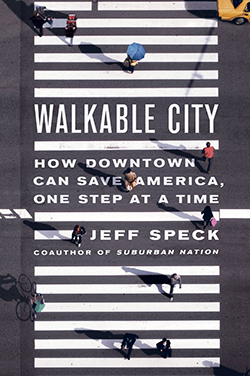 With intellectual cunning and great prose, Jeff Speck diagnoses the disconnect between what planners know about how to make cities livable, and what most of America’s small and midsized cities are or (mostly) aren’t doing to encourage “wealth, health, and sustainability.” According to Speck, walkability is the one issue around which the livability and vitality of cities depends. “Get walkability right, “ he says, “and so much of the rest will follow.” To that end, Speck outlines ten essential “steps” for creating walkability, and ushering in “a new era of street life in America.”
With intellectual cunning and great prose, Jeff Speck diagnoses the disconnect between what planners know about how to make cities livable, and what most of America’s small and midsized cities are or (mostly) aren’t doing to encourage “wealth, health, and sustainability.” According to Speck, walkability is the one issue around which the livability and vitality of cities depends. “Get walkability right, “ he says, “and so much of the rest will follow.” To that end, Speck outlines ten essential “steps” for creating walkability, and ushering in “a new era of street life in America.”
Editor’s Note: In the interest of full disclosure, the publisher of this book is an advertiser on the Planetizen website, and has previously advertised this book on the site. Buy the book.
Goodreads rating: 4.29 (3,617 ratings).
2013
Happy City: Transforming Our Lives Through Urban Design
Charles Montgomery
Farrar, Straus and Giroux, 368 pages
 Charles Montgomery ponders, “is urban design really powerful enough to make or break happiness?” In an engaging new book, he explores the philosophy and the psychology of happiness as it relates to urban denizens. In proposing a ‘basic recipe of urban happiness’, Happy Cities contrasts progressive, sustainable, ‘new urbanist’ and ‘peer-to-peer’ values with the commercialized, auto-centric and top-down planning of the last century.
Charles Montgomery ponders, “is urban design really powerful enough to make or break happiness?” In an engaging new book, he explores the philosophy and the psychology of happiness as it relates to urban denizens. In proposing a ‘basic recipe of urban happiness’, Happy Cities contrasts progressive, sustainable, ‘new urbanist’ and ‘peer-to-peer’ values with the commercialized, auto-centric and top-down planning of the last century.
Montgomery posits that until the last two decades, science lacked the ability to describe a relationship between design, psychology and social livability. Newer neurological testing instruments such as EEG and FMRI and a broadening of the definition of “happiness” beyond economic utility allows researchers to understand more subjective forms of happiness relating to experience, relationships and place. The book offers a tome of research providing planners and designers with the scientific vocabulary to discuss street engineering and community building in terms of mental and physical health.
Among many engaging examples, Happy Cities cites the rise of chronic cortisol release, associated with stress and heart disease, in commuters with uncertain transit routes or depressingly long commute times. Montgomery delves into the ‘oxytocin’ molecule, and recent evidence that peer-to-peer networks may also increase ego-reinforcing neurological connections to promote trust. The book also explores how bike culture reflects the viewpoint of ‘beta- endorphin pumped, risk taking’ cyclists rather than the needs of the ‘peripheral-vision challenged’ kids and seniors that are trying to share the road. Happy Cities ultimately advocates a ‘Redesign for Freedom’ and asserts this as a right of every citizen via Henri Lefebvre. Buy the book.
Goodreads rating: 4.34 (3,872 ratings).
2015
The Invention of Nature: Alexander Von Humboldt's New World
Andrea Wulf
Alfred A. Knopf
September 15, 2015, 496 pages
 Alexander Von Humboldt is one of the most famous human beings to ever walk the face of the earth. And walk the face of the earth, he certainly did.
Alexander Von Humboldt is one of the most famous human beings to ever walk the face of the earth. And walk the face of the earth, he certainly did.
On September 14, 1869, on the centennial of Humboldt's birth, people living in cities in Europe, Africa, Australia, North America, and South America took to the streets to celebrate his name. Since that time, you might have noticed (or not noticed, as it were), Alexander Von Humboldt the man has receded from prominence, but the influence of his intelligence lives on.
Alexander Von Humboldt is no less than the forefather of environmentalism—the first to conceive of a natural world connected and intertwined like a web. As described by Andre Wulf, "He saw the world as one great living organism where everything is connected, conceiving a bold new vision of nature that still influences the way that we understand the natural world."
Thanks to the clear and animated prose of Wulf, the intelligence and adventurous spirit of Humboldt comes alive on the page. Wulf artfully traces the journeys and experiments of Humboldt's life, into conversations with people like Johann Wolfgang von Goethe, Thomas Jefferson, and Simón Bolívar, and through his influence on people like Henry David Thoreau, John Muir, and Charles Darwin.
For planners and others concerned with building a sustainable and healthy world for later generations to inherit, Humboldt's towering influence is made clear from an anecdote early in his life. Exploring the Lake Valencia area of present-day Venezuela, Humboldt concluded that deforestation had changed the climate of the area. "As Humbdolt described how humankind was changing the climate, he unwittingly became the father of the environmental movement," writes Wulf.
The reader should be warned, however, that no small amount of envy should be expected while reading this book—both for the world of Humboldt's day, with so many possibilities for exploration and discovery, and for the world of today, suffering from a lack of recognition and celebration of Humboldt's example. Buy the book.
Read the New York Times "Ten best Books of 2015" list.
Goodreads rating: 4.33 (11,473 ratings).
Tactical Urbanism: Short-term Action for Long-term Change
Mike Lydon and Anthony Garcia
Island Press
March 17, 2015, 256 pages
There comes a moment in the course of every nascent trend when we must ask, "is that a thing?" For tactical urbanism, that moment has been coming at least since 2008, when the (re)Bar collective deposited its first temporary minipark to inaugurate National Park(ing) Day. It's been coming since Mayor Bloomberg closed Times Square. And it's been coming since people in Los Angeles started referring to gourmet food trucks unironically. Or maybe it's been coming for a much longer time, since the days of stickball in the street, hopscotch on the sidewalk, and bartering at the crossroads.
In any event, we now can be pretty sure of the answer: yes. Tactical urbanism is indeed a thing. Tactical Urbanism: Short-term Action for Long-term Change reifies the trend once and for all. Tactical urbanism has hit the mainstream now for four reasons, according to Lydon and Garcia: shifting demographics, radical connectivity, the Great Recession, and citizen frustration. They translate to, respectively, millenials' return to center cities, the Internet and smart phones, and the high cost of development; the last one is self-explanatory.
Tactical Urbanism serves as a how-to guide for activists who want to get in on the action. There's not a lot of theorizing in Tactical Urbanism, which is probably for the best. Surely future scholars will have a field day with the trends that planners, and citizen-planners, are exploring today. Nowhere are ideas like Henri Lefebvre's "right to the city" more in question than when citizens take planning into their own hands. For now, though, everyone seems to be rolling up their sleeves and getting out the sidewalk chalk. Buy the book.
Read the California Planning & Development Report review.
Goodreads rating: 3.94 (155 ratings)
Zoned in the USA: The Origins and Implications of American Land-Use Regulation
Sonja Hirt
Cornell University Press
Dec 4, 2014, 256 Pages
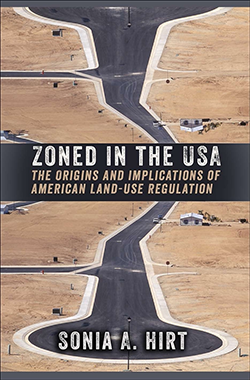 In her surprisingly rousing analysis and history of American zoning laws, Zoned in the USA, Sonja Hirt asks, essentially, why everything in the United State is so damn far away from everything else. It takes an outsider like Hirt—who is Bulgarian and therefore familiar with both European cities and governmental power—to recognize the stark differences between the control of land in American cities and that in their counterparts elsewhere in the developed world. A professor of planning at Virginia Tech, Hirt positions herself as the Alexis de Toqueville of planning, equally baffled and fascinated by the odd world that Americans have built.
In her surprisingly rousing analysis and history of American zoning laws, Zoned in the USA, Sonja Hirt asks, essentially, why everything in the United State is so damn far away from everything else. It takes an outsider like Hirt—who is Bulgarian and therefore familiar with both European cities and governmental power—to recognize the stark differences between the control of land in American cities and that in their counterparts elsewhere in the developed world. A professor of planning at Virginia Tech, Hirt positions herself as the Alexis de Toqueville of planning, equally baffled and fascinated by the odd world that Americans have built.
Hirt grounds her inquiry in a paradox: Americans proclaim their love for freedom and private property rights, and yet they gleefully submit to "tedious laws governing the building of their everyday environments and way of life." These laws, directly and indirectly, serve a single goal: that of promoting neighborhoods dedicated to the single-family detached home.
Thought Hirt often does not hide her bafflement, Zoned in the USA is that rare book that has a perspective but not an agenda. It likewise carries the heft of research but is compelling, and convincing, enough—sometimes just barely—to be one of the more enjoyable scholarly texts on what can be a dreadfully dull topic. It's a worthy tangent to the sociological insights of Crabgrass Frontier, and a steely rejoinder to Wendell Cox, Robert Breugemann, Joel Kotkin, and other conservatives who claim that suburban sprawl merely reflects market demand. Hirt writes, "As Foucault teaches us, rules and institutions that we often take for granted are far from 'natural'; they were simply made up at some point in time." Buy the book.
Goodreads rating: 4.12 (49 ratings)
Zoning Rules!: The Economics of Land Use Regulation
William A. Fischel
Lincoln Institute of Land Policy
July 10, 2015, 432 Pages
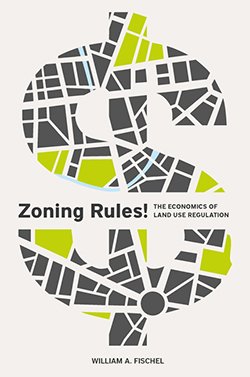 Zoning Rules! is not for the casual reader or the faint of heart. It is a dense, comprehensive analysis of something that almost defies analysis and yet "rules" every facet of American urban life: zoning. The impacts of zoning, especially its economic impacts, are elusive because zoning by definition cannot be studied with control groups. In Zoning Rules!, William Fischel does exhaustive work to determine exactly what the economic costs and benefits are of zoning regulations across the United States.
Zoning Rules! is not for the casual reader or the faint of heart. It is a dense, comprehensive analysis of something that almost defies analysis and yet "rules" every facet of American urban life: zoning. The impacts of zoning, especially its economic impacts, are elusive because zoning by definition cannot be studied with control groups. In Zoning Rules!, William Fischel does exhaustive work to determine exactly what the economic costs and benefits are of zoning regulations across the United States.
A free-market advocate, Fischel has disheartening news for the 20th century planners who followed a prescriptive, restrictive model: "State, federal, and judicial interventions to control local zoning have done more harm than good. To help grow the economy, decrease inequality, and improve the environment, America needs to take the wind out of the sails of local land use regulation." Then again, for every counterproductive market distortion that Fischel identifies, there's a young planners and a progressive city that has the chance to un-do some of the damage. These days, zoning serves mainly to prop up home values in single-family neighborhoods. For everyone else, it's a losing proposition.
Fischel calls for abolishing more than just zoning. He's also not a fan of urban growth boundaries, rent control, mortgage tax subsidies, and other influences that, he writes, keep cities from realizing their economic potential. Buy the book.
Goodreads rating: 4.21(33 ratings).
2016
Evicted: Poverty and Profit in the American City
Matthew Desmond
Crown
March 1, 2016, 432 pages
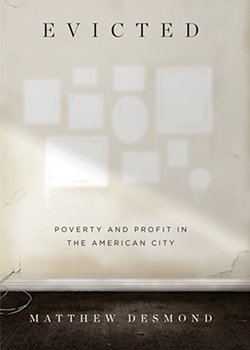 Evicted is a meticulous, conscientious account of the plague of evictions that pervade America's low-income communities. A seasoned scholar, Matthew Desmond embedded himself in Milwaukee to observe firsthand the experiences of landlords and residents, the latter teetering on the edge of financial ruin and the former teetering on the edge of what the law allows. As a primary source, Evicted is masterful, telling stories that, though we can likely imagine them, generally do not get told because of the marginalization of the victims of eviction and the furtiveness of the evictors.
Evicted is a meticulous, conscientious account of the plague of evictions that pervade America's low-income communities. A seasoned scholar, Matthew Desmond embedded himself in Milwaukee to observe firsthand the experiences of landlords and residents, the latter teetering on the edge of financial ruin and the former teetering on the edge of what the law allows. As a primary source, Evicted is masterful, telling stories that, though we can likely imagine them, generally do not get told because of the marginalization of the victims of eviction and the furtiveness of the evictors.
What Evicted lacks are the statistics and policy analyses to explain how housing in America became so fraught. Then again, statistics are not hard to come by. Desmond attempts to portray the lives behind the statistics in such a way that might spur policymakers to action. Even with Desmond's heartfelt stories, Milwaukee is still burning and millions of Americans live in fear of life out on the street. Buy the book.
Goodreads rating: 4.48 (50,968 ratings).
Streetfight: Handbook for an Urban Revolution
Janette Sadik-Khan and Seth Solomonow
Viking
March 8, 2016, 368 pages
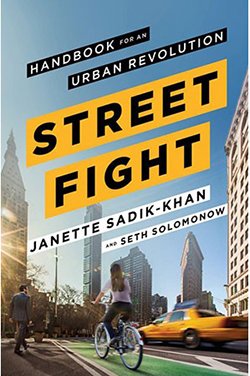 Few books over the years have been such obvious choices for Planetizen’s Top Books list as Streetfight. Indeed, the story that Streetfight tells long preceded the book. As New York City transportation director under Mayor Michael Bloomberg, Janette Sadik-Khan promoted progressive transportation policy on the grandest scale. She accommodated and even favored walking, biking, and public transit over automobiles, and she championed tactical urbanism even before the term came into vogue. As brash personality befitting her city, Sadik-Khan got into her share of "fights," many of which form the basis of her narrative.
Few books over the years have been such obvious choices for Planetizen’s Top Books list as Streetfight. Indeed, the story that Streetfight tells long preceded the book. As New York City transportation director under Mayor Michael Bloomberg, Janette Sadik-Khan promoted progressive transportation policy on the grandest scale. She accommodated and even favored walking, biking, and public transit over automobiles, and she championed tactical urbanism even before the term came into vogue. As brash personality befitting her city, Sadik-Khan got into her share of "fights," many of which form the basis of her narrative.
In many ways, Sadik-Khan exemplifies the value of self-promotion: a planning official who is not afraid to expose herself and "fight" for her plans—even in the face of some unhinged opposition—can accomplish a great deal. Then again, though it includes some key insights—Sadik-Khan is all about quantitative analysis, even for interventions that seem to transcend data—Streetfight isn't so much a "handbook" as it is an inspiration. As Sadik-Khan acknowledges, local activists and officials always have to adapt to their local cultures, regulations, and built environments. So it's hard to tell whether a personality that can make it in New York would make it in any town that is less toddling. Buy the book.
Goodreads rating: 4.31(897 ratings).
2017
The Color of Law: The Forgotten History of How Our Government Segregated America
Richard Rothstein
Liveright
May 2, 2017, 368 pages
As author Richard Rothstein describes, not long after moving into their new suburban home, Bill Myers faced a crowd of 300 white faces not-so-politely asking them to vacate the neighborhood. Protests persisted, led by KKK members and ignore by police. After four years, Myers complied.
This happened in 1961, not 1860. And it happened in suburban Philadelphia, not Birmingham or Jackson. Plenty of those neighbors are probably still alive. And still voting.
Urban planners do not necessarily bear the greatest responsibility for America's fervor for segregation. In fact, Rothstein rarely, if ever, refers to them directly. But they surely bear some of it. That's because, right up to the 1960s, cities, suburbs, and financial institutions across the United States employed every legal and quasi-legal means possible to keep whites and blacks as segregated as if if they were living on different continents. This of course includes zoning. It was, in fact, the raison d’être of many towns.
We're all abstractly familiar with the practices of redlining, discriminatory lending, and so forth, but those buzzwords are just the beginning. As Rothstein lays out, segregation was a decentralized but deliberate, de facto effort that involved governments, courts, the real estate industry, and everyday citizens alike. The effects—on African-Americans individually and on our cities and society generally—were and are devastating.
Rothstein's book is important, but it's still flawed. Some chapters are cursory. He relies too much on isolated anecdotes, and not enough on data, to make assertions about nationwide trends. But the point should be well taken by planners: whatever role they played in writing discriminatory zoning laws and helping banks cordon off neighbors, contemporary planners—and all compassionate Americans—should dedicate themselves to righting the wrongs that Rothstein ably chronicles. Buy the book.
Goodreads rating: 4.43 (5,966 ratings).
The New Urban Crisis: How Our Cities Are Increasing Inequality, Deepening Segregation, and Failing the Middle Class—and What We Can Do About It
Richard Florida
Basic Books
April 11, 2017, 336 pages
Divisive though he may be, Richard Florida deserves due credit for popularizing many current planning trends. This year, in the New Urban Crisis, Florida finally acknowledged a trend that most people wish was far less popular—inequity within cities and among cities. Florida focuses on the "superstar cities" that have made it big, and on the rest, which have been left behind. And he acknowledges that economic success for many city-dwellers—the proverbial hipsters and one-percenters—has been countered by housing shortages, blight, and crushing costs of living for many of their neighbors.
Florida defines these intra-urban problems as inequality, segregation, and sorting. He offers a slew of data to describe these patterns, some of it almost comical in its precision. He offers data sets to rank cities according to different types of segregation: Segregation of the Wealthy; Segregation of the Less Educated; Segregation of College Grads; Educational Segregation; Creative Class Segregation; Service Class Segregation, etc.
The New Urban Crisis lacks much of the dazzle that characterizes Florida's earlier work—he's like a Taylor Swift fan who just discovered Morrissey. Previously, Florida presaged, and encouraged, ebullient trends that hadn't happened yet. This time, he's describing depressing things of which many urbanites are all too aware. Whether Florida should have been aware of them—ahead of time—is the question that hangs over the book. Indeed, it's a question that all of us should be asking ourselves. Buy the book.
Goodreads rating: 3.49 (641 ratings).
2018
The Divided City: Poverty and Prosperity in Urban America
Alan Mallach
Island Press
June 2018, 344 pages
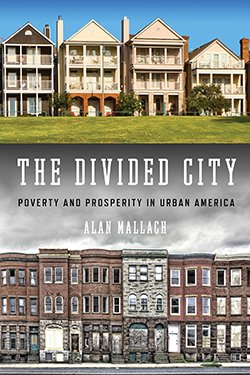 While the rise of America's superstar cities has inspired both excited theorizing ("the creative class!") and reactionary criticism ("gentrification!"), less prosperous cities of the Rust Belt and the East Coast have patiently waited for the sensitive, nuanced, well informed discussion they deserve and need. The Divided City is that discussion. Urban scholar Alan Mallach investigates the decline and rise of cities ranging from Detroit to Cleveland to Buffalo to Baltimore, describing exactly what went wrong and discerning how wrong it went. In many cases, cities that seem like failures aren't nearly as down-and-out as their images would suggest. Mallach covers the major issues: deindustrialization, racism and segregation, investment and disinvestment, vacancy, and, of course, displacement and gentrification. The latter phenomenon he ascribes not to invasion by the haves against the have-nots but rather to "global and national increases in economic inequality, demographic shifts, changes in employment, aging of the urban housing stock, suburban out-migration of middle-class black families, and the continue fallout from the foreclosure crisis." It's nuanced, indeed.
While the rise of America's superstar cities has inspired both excited theorizing ("the creative class!") and reactionary criticism ("gentrification!"), less prosperous cities of the Rust Belt and the East Coast have patiently waited for the sensitive, nuanced, well informed discussion they deserve and need. The Divided City is that discussion. Urban scholar Alan Mallach investigates the decline and rise of cities ranging from Detroit to Cleveland to Buffalo to Baltimore, describing exactly what went wrong and discerning how wrong it went. In many cases, cities that seem like failures aren't nearly as down-and-out as their images would suggest. Mallach covers the major issues: deindustrialization, racism and segregation, investment and disinvestment, vacancy, and, of course, displacement and gentrification. The latter phenomenon he ascribes not to invasion by the haves against the have-nots but rather to "global and national increases in economic inequality, demographic shifts, changes in employment, aging of the urban housing stock, suburban out-migration of middle-class black families, and the continue fallout from the foreclosure crisis." It's nuanced, indeed.
While Mallach is objective, even-handed, and scholarly, he is not distant. He treats cities and their residents sensitively, countering stereotypes and conveying cautious optimism. He is schooled in urban economics and sensitive to the causes of inclusion and equity. As he writes, "these cities matter," he continues, "we need to admire their efforts and celebrate their achievements, but we also need to drill down to understand why, for all their hard work over many decades, things are not getting better." Mallach ultimately argues that the key to reviving America's industrial, legacy cities is not urban renewal, eds and meds, shiny new stadiums, federal programs, or anything else. It is, a little bit of everything—and it requires a great deal of thought and care. On that count, Mallach leads the way. Buy the book.
Goodreads rating: 4.39 (76 ratings).

Plan to Potentially Remove Downtown Milwaukee’s Interstate Faces Public Scrutiny
The public is weighing in on a suite of options for repairing, replacing, or removing Interstate 794 in downtown Milwaukee.

‘Forward Together’ Bus System Redesign Rolling Out in Portland
Portland is redesigning its bus system to respond to the changing patterns of the post-pandemic world—with twin goals of increasing ridership and improving equity.

Can New York City Go Green Without Renewable Rikers?
New York City’s bold proposal to close the jail on Rikers Island and replace it with green infrastructure is in jeopardy. Will this compromise the city’s ambitious climate goals?

700-Acre Master-Planned Community Planned in Utah
A massive development plan is taking shape for lakefront property in Vineyard, Utah—on the site of a former U.S. Steel Geneva Works facility.

More Cities Ponder the End of Drive-Thrus
Drive-thru fast food restaurants might be a staple of American life, but several U.S. cities are actively considering prohibiting the development of new drive-thrus for the benefit of traffic safety, air quality, and congestion.

Air Pollution World’s Worst Public Health Threat, Report Says
Air pollution is more likely to take years life off the lifespan of the average human than any other external factor, according to a recent report out of the University of Chicago.
Placer County
City of Morganton
HUD's Office of Policy Development and Research
Dongguan Binhaiwan Bay Area Management Committee
City of Waukesha, WI
Los Angeles County Metropolitan Transportation Authority
Indiana Borough
Write for Planetizen
Urban Design for Planners 1: Software Tools
This six-course series explores essential urban design concepts using open source software and equips planners with the tools they need to participate fully in the urban design process.
Planning for Universal Design
Learn the tools for implementing Universal Design in planning regulations.



